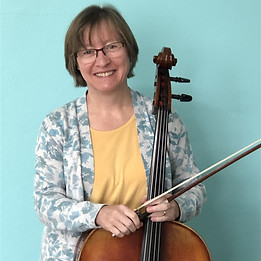Cello Lessons in Grants Pass
The cello is a magnificent instrument with a warm, rich tone that can express deep emotion and bring music to life. Essential in classical orchestras and featured in everything from movie soundtracks and popular songs to contemporary Christian music and even rock bands, the cello has a unique voice that resonates across genres. Whether you're drawn to its soulful melodies or powerful presence, our cello lessons in Southern Oregon will guide you on a musical journey that’s both inspiring
and rewarding.
What you Will Learn in Cello Lessons:
Students in our cello lessons learn the fundamentals common to playing both classical and popular music including playing position, bowing technique, scales, and classic songs with a focus on playing in tune. As a student begins to master these foundational skills in their cello lessons, they will work with their teacher to learn the techniques needed to play the styles of music they love.
A Little Info About the Cello:
The cello (short for violoncello) is sometimes compared to the the human voice because its range encompasses the notes sung by all four human voices - the bass, tenor, alto, and soprano. It's rich, mellow tone touches the heart much as the human voice does. In an orchestra cellos and double basses provide the low harmony, with the cello often playing the melody for brief sections or for extended sections when featured in a cello concerto. The cello is also used extensively in popular music.
Did you Know that Cellos are Featured in All Musical Styles?
In the 1960s The Beatles incorporated the cello in songs such as "Yesterday", "Eleanor Rigby" and "Strawberry Fields Forever." The Beach Boys also utilized the cello in their innovative song, "Good Vibrations". In the 1970's the Electric Light Orchestra included the cello and violin in their rock/classical fusion style. Other bands incorporating the cello include Aerosmith, Nirvana, Oasis, Smashing Pumpkins, and OneRepublic. The cello is also used in bluegrass and folk music, even appearing in some Celtic folk music performances with the performers demonstrating the skills and techniques of traditional fiddle playing.
Where to Find a Cello:
You or your child will need a cello that is the correct size for your height. Renting with the option to buy is a good way to purchase an instrument for your cello lessons, since rental plans usually let you trade your instrument in for a larger size as you grow.
We recommend Great Northwest Music for cello rentals - they will be able to tell you what size is best for you and get you set up with everything you need for your lessons.
If you are interested in purchasing one or if yours needs repair or a new bow, we recommend Holst Violins, a home based violin-family instrument shop.
Contact Brad Holst at 541-622-3540.
FAQs:
What size of cello will my child need?
There are several ways to size a cello. One method is based on your child's height: 1/8 to 1/4 size—below 4 feet 1/2 size—4 to 4 1/2 feet 3/4 size—4 1/2 to 5 feet 4/4 size—5 feet and above
What accessories do I need?
-Bow -Rosin -End Pin Anchor
How much will I need to practice?
It will be important for you to play the cello regularly to make progress in lessons. We recommend that beginners practice 15-30 minutes daily. Playing the cello can result in sore fingers at the beginning, so it is may help to split practice time into two sessions a day for 10 minutes with several hours in between to give sore fingers time to rest. As you practices regularly, you will eventually develop callouses on your fingers so that they no longer hurt. At that point, you can play for longer periods of time. The more time a musician practices, the faster they progress in their playing.
Is it possible to schedule lessons every other week (biweekly)?
It could possibly work during the school day, but not after 2:00 pm since these times are in such high demand. Also in our experience, we have found that although it can work for adults, biweekly lessons with children are generally not successful. They need the consistency of weekly support from their teacher. The classical guitar with nylon strings is the most common to find in smaller sizes and It is also best for young beginners since it is easier on their fingers. After your child has built up some callouses and is ready to move up a size, they can change to a steel string guitar if that is their preference. GUITAR SIZE HEIGHT 1/4 Size Guitar - up to 3'9" tall 1/2 Size Guitar - up to 4'3" tall 3/4 Size Guitar - up to 4'11" tall 7/8 Size Guitar - up to 5'1" tall Full Size Guitar - 5'2 and taller When you invest in guitar lessons for your child it is very important that you also invest in a quality guitar. Inexpensive guitars often have a higher action (distance from string to the fretboard) that makes the guitar difficult to play. A quality guitar will be much easier to play, and your child will be proud of the beautiful sound it makes. Since it will be more fun to play, your child will enjoy practicing more and make better progress in their lessons.
“Music is the language of the spirit. It opens the secret of life...”
~Kahlil Gibran





